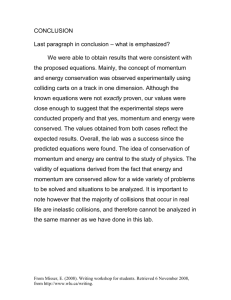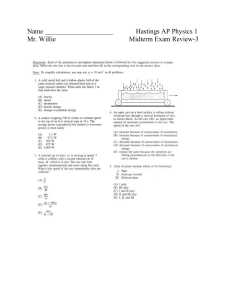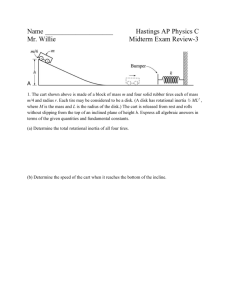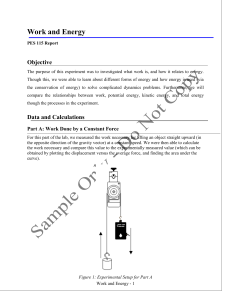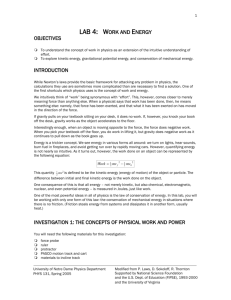Energy_and_Momentum2a - UCLA Physics & Astronomy
advertisement
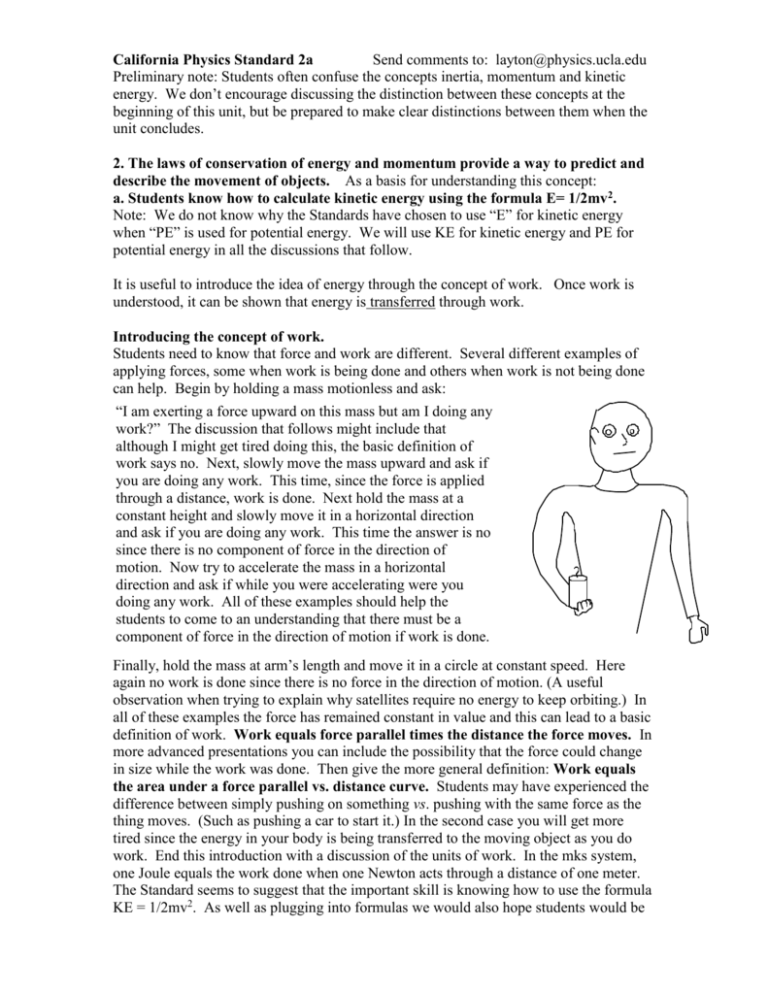
California Physics Standard 2a Send comments to: layton@physics.ucla.edu Preliminary note: Students often confuse the concepts inertia, momentum and kinetic energy. We don’t encourage discussing the distinction between these concepts at the beginning of this unit, but be prepared to make clear distinctions between them when the unit concludes. 2. The laws of conservation of energy and momentum provide a way to predict and describe the movement of objects. As a basis for understanding this concept: a. Students know how to calculate kinetic energy using the formula E= 1/2mv2. Note: We do not know why the Standards have chosen to use “E” for kinetic energy when “PE” is used for potential energy. We will use KE for kinetic energy and PE for potential energy in all the discussions that follow. It is useful to introduce the idea of energy through the concept of work. Once work is understood, it can be shown that energy is transferred through work. Introducing the concept of work. Students need to know that force and work are different. Several different examples of applying forces, some when work is being done and others when work is not being done can help. Begin by holding a mass motionless and ask: “I am exerting a force upward on this mass but am I doing any work?” The discussion that follows might include that although I might get tired doing this, the basic definition of work says no. Next, slowly move the mass upward and ask if you are doing any work. This time, since the force is applied through a distance, work is done. Next hold the mass at a constant height and slowly move it in a horizontal direction and ask if you are doing any work. This time the answer is no since there is no component of force in the direction of motion. Now try to accelerate the mass in a horizontal direction and ask if while you were accelerating were you doing any work. All of these examples should help the students to come to an understanding that there must be a component of force in the direction of motion if work is done. Finally, hold the mass at arm’s length and move it in a circle at constant speed. Here again no work is done since there is no force in the direction of motion. (A useful observation when trying to explain why satellites require no energy to keep orbiting.) In all of these examples the force has remained constant in value and this can lead to a basic definition of work. Work equals force parallel times the distance the force moves. In more advanced presentations you can include the possibility that the force could change in size while the work was done. Then give the more general definition: Work equals the area under a force parallel vs. distance curve. Students may have experienced the difference between simply pushing on something vs. pushing with the same force as the thing moves. (Such as pushing a car to start it.) In the second case you will get more tired since the energy in your body is being transferred to the moving object as you do work. End this introduction with a discussion of the units of work. In the mks system, one Joule equals the work done when one Newton acts through a distance of one meter. The Standard seems to suggest that the important skill is knowing how to use the formula KE = 1/2mv2. As well as plugging into formulas we would also hope students would be brought to understand that kinetic energy is the work done by an unbalanced force. This might be demonstrated with a mathematical derivation as follows*: A constant force F is applied to a frictionless cart of mass m while it moves a distance d. The work done on the mass is F d. From Newton’s 2nd law, the work becomes m a d. Since when an object F F d uniformly accelerates from rest it can be shown (see * below) that ad =1/2v2, it follows that the total work done in accelerating the mass is 1/2mv2. This very useful result says that the work of an unbalanced force = 1/2mv2 and this “energy of motion” is called kinetic energy or KE. The above derivation suggests a simple and direct experiment to measure kinetic energy. The work of an unbalanced force turns into KE. The experiment involves a small fairly frictionless cart, a spring balance, a stopwatch and a level surface long enough to allow for some acceleration followed by a measured distance at constant speed. Measure the mass of the cart (perhaps including additional Acceleration space Coasting space masses), and measure the distance between the two “accelerating distance tapes” and the distance between the two “coast velocity tapes”. The string attached to the cart is long enough to allow dropping the force to zero when the cart passes the second tape. The cart will be timed as it coasts at constant velocity between the second and third tape. The experiment can be repeated with different mass configurations but it is important to supply a constant force to the cart during the acceleration phase. This experiment can test to see if the work done in accelerating the cart equals the final kinetic energy of the cart. (Even though the results may not be great, students get to experience doing work and observing the resulting kinetic energy.) The work of an unbalanced force equals change in kinetic energy. FU d = 1/2mv2 * This derivation assumes that when the formulas for kinematics were developed, the following was done: Starting from rest, we have shown that v = at and d = ½ at2 Eliminating t between these two equations yields: v2 = 2ad (or, for the above, ad = 1/2v2)






